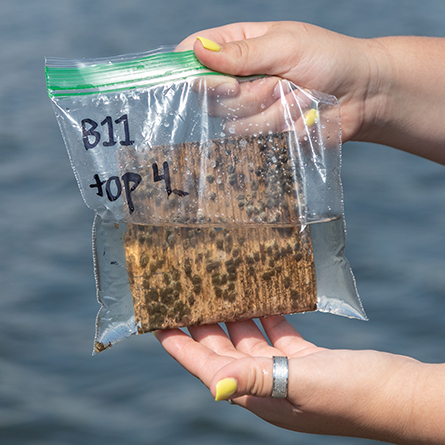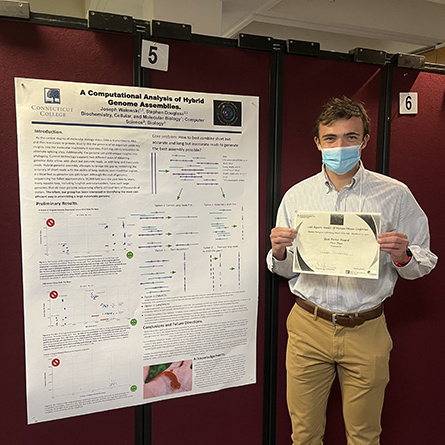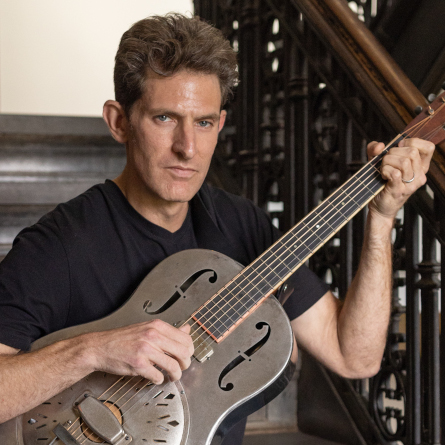
Joseph Walewski ’23 wins ‘Best Student Poster’ at Aquatic Models of Human Disease Conference
At his very first professional scientific conference, Joseph Walewski ’23 made quite an impression.
He was one of only four undergraduate students at the 10th annual Aquatic Models of Human Disease Conference, hosted this fall by the University of Chicago Marine Biological Laboratory in Woods Hole, Mass., and he was both excited and nervous to present his own research to the field’s top experts, including the author of many of the genomics papers that have informed his own work.
That work thoroughly impressed the conference judges, who awarded Walewski the “Best Student Poster” prize over more than three dozen Ph.D. students from around the country.
“I was shocked,” said Walewski, a biochemistry, cellular and molecular biology (BCMB) and computer science double major from Fairfield, Conn. “I am very proud of the work I do, and I try to dedicate as much time to it as possible, but I was truly humbled to be awarded ‘Best Poster.’ I am very excited to see where this takes my career.”
Walewski’s research, which he is conducting under the mentorship of Assistant Professor of Bioinformatics Stephen Douglass, is focused on finding the most cost-effective way to obtain an organism’s genome. He’s specifically interested in sequencing and assembling the genome of the eastern newt, a salamander native to Connecticut that has an exceptional ability to regenerate not only its limbs and tails, but also structures as complicated as its eyes, heart and brain.
Walewski became interested in the salamander project while taking “Introduction to Biological Inquiry” with Douglass during his first year at Conn. But the eastern newt’s genome is roughly 10 times the size of the human genome, meaning the process would be lengthy and, perhaps more prohibitive, expensive.
“The sequencing technology is very new, and although costs have fallen 10,000 times in the past 20 years, for large genomes the process still costs tens of thousands of dollars, if not hundreds of thousands of dollars,” Walewski said.
But the challenge didn’t deter Walewski, a varsity track and field and cross-country athlete who regularly completes running challenges of his own making. He began studying computer science and used Conn’s Summer Science Research Institute funding to build a computer that could handle the complex simulation work necessary to compare two different genome assembly strategies and determine the most accurate and cost-efficient method.
“We have encountered more than one problem that I would describe as ‘prohibitive,’” Douglass said of the project. “Each time, Joe found a way through, solved the problem and kept on going.”
At the conference, Walewski presented “A Computational Analysis of Hybrid Genome Assemblies,” which detailed the preliminary results from his work using the two different approaches to simulate sequence reads for four different species with various genome sizes. Those initial findings show that one option, which focuses on using shorter, highly accurate sequence reads to assemble the larger genome, appears to be the superior method, regardless of the genome size.
“These findings have implications in countless fields, as genome sequencing is used in human health and medicine, molecular biology, ecology, agriculture and so many industries,” Walewski said.
Walewski and Douglass now plan to publish their results in an academic journal. Then, in his final semester at Conn, Walewski will officially sequence the genome of the eastern newt, realizing the goal he set in his first year.
“Joe’s dedication to and passion for this project are contagious,” Douglass said. “Being awarded first place at the conference is quite an accomplishment—the judges acknowledged the scientific rigor and originality of Joe’s work.”
After graduation, Walewski plans to pursue a dual M.D./Ph.D. to further investigate the regenerative abilities of salamanders.
“My hope is that we can one day apply this knowledge in a way that helps people suffering from tissue/organ loss, amputation, neurodegenerative diseases and many more ailments,” he said.

